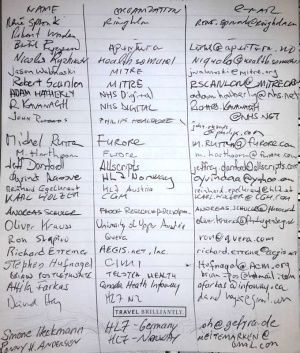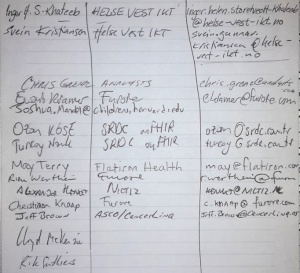This wiki has undergone a migration to Confluence found Here
Difference between revisions of "AID 201705 Meeting in Madrid"
Jump to navigation
Jump to search
Rene spronk (talk | contribs) |
Rene spronk (talk | contribs) |
||
| (One intermediate revision by the same user not shown) | |||
| Line 28: | Line 28: | ||
##*To make a FHIR Server from an existing healthcare relational database, you have to develop transforms between FHIR resources and the native database formats - in both directions (for GET and PUT). One way to do this is to use the FHIR Transform Engine. This gives bi-directional transforms from declarative mappings - saving coding effort, and increasing reliability. Transforms integrate with the HAPI server engine. An example implementation is described. | ##*To make a FHIR Server from an existing healthcare relational database, you have to develop transforms between FHIR resources and the native database formats - in both directions (for GET and PUT). One way to do this is to use the FHIR Transform Engine. This gives bi-directional transforms from declarative mappings - saving coding effort, and increasing reliability. Transforms integrate with the HAPI server engine. An example implementation is described. | ||
##*There is an important side-benefit to this approach. RESTFul FHIR searches are converted to efficient SQL queries, automatically - supporting a wide range of searches without coding. | ##*There is an important side-benefit to this approach. RESTFul FHIR searches are converted to efficient SQL queries, automatically - supporting a wide range of searches without coding. | ||
| − | ##Building a FHIR facade for an existing GP system (Christiaan Knaap, Furore, NL) | + | ##Building a FHIR facade for an existing GP system (Christiaan Knaap, Furore, NL, see [https://vimeo.com/216803627 https://vimeo.com/216803627] for a recording of the presentation, which had no slide deck) |
##*We have used Vonk to implement a FHIR façade to an existing GP system to open up the data to patients. We had to bridge the gap between the system’s database schema and FHIR resources, map search parameters and apply authorization based on the OAuth2 token for the patient. I will discuss the setup of the solution, what Vonk offers out of the box and what had to be coded specifically for this use case, along with difficulties we encountered. | ##*We have used Vonk to implement a FHIR façade to an existing GP system to open up the data to patients. We had to bridge the gap between the system’s database schema and FHIR resources, map search parameters and apply authorization based on the OAuth2 token for the patient. I will discuss the setup of the solution, what Vonk offers out of the box and what had to be coded specifically for this use case, along with difficulties we encountered. | ||
#Other FHIR related presentations | #Other FHIR related presentations | ||
| Line 38: | Line 38: | ||
##*Generate a form design from any FHIR profile or bundle; refine the design for specific use cases | ##*Generate a form design from any FHIR profile or bundle; refine the design for specific use cases | ||
##*Form can be used to view or edit FHIR resources and bundles; or for clinical validation of profiles | ##*Form can be used to view or edit FHIR resources and bundles; or for clinical validation of profiles | ||
| − | ##Dynamically Configurable Scalable FHIR Repository (Tuncay Namli, SRDC onFHIR, Turkey) | + | ##Dynamically Configurable Scalable FHIR Repository (Tuncay Namli, SRDC onFHIR, Turkey, see [http://www.hl7.org/documentcenter/public/wg/java/SRDConFHIR.pptx http://www.hl7.org/documentcenter/public/wg/java/SRDConFHIR.pptx] for slides) |
#Adjournement at 16:45 | #Adjournement at 16:45 | ||
Latest revision as of 06:18, 11 May 2017
Return to: WGM Minutes > 2017 > May Madrid
These are the minutes of the AID WG for the WGM in Madrid ES, May 2017.
Contents
Sunday Q3/Q4 (joint with FHIR)
| Workgroup | Date/Time | Location | Chair/Scribe |
|---|---|---|---|
| AID HL7 User Group (hosting FHIR) | 2017-05-07, 14:45-18:00 |
Madrid, ES | Chair/Scribe: Rene Spronk |
Attendees
- Rene Spronk, co-chair & scribe
- 38 other particpants, see scanned attendee list below
Agenda
- Rene calls to order at 14:45
- FHIR and legacy databases
- Architecting a FHIR frontend using a legacy database backend, (Rene Spronk, Ringholm, NL, see http://www.hl7.org/documentcenter/public/wg/java/FHIR_and_legacy_database.ppt for slides)
- High level introductory discussion of implementation issues
- Building FHIR Servers on existing Relational Databases (Robert Worden, , UK, see http://www.hl7.org/documentcenter/public/wg/java/FTE%20for%20WGM.pptx for slides)
- To make a FHIR Server from an existing healthcare relational database, you have to develop transforms between FHIR resources and the native database formats - in both directions (for GET and PUT). One way to do this is to use the FHIR Transform Engine. This gives bi-directional transforms from declarative mappings - saving coding effort, and increasing reliability. Transforms integrate with the HAPI server engine. An example implementation is described.
- There is an important side-benefit to this approach. RESTFul FHIR searches are converted to efficient SQL queries, automatically - supporting a wide range of searches without coding.
- Building a FHIR facade for an existing GP system (Christiaan Knaap, Furore, NL, see https://vimeo.com/216803627 for a recording of the presentation, which had no slide deck)
- We have used Vonk to implement a FHIR façade to an existing GP system to open up the data to patients. We had to bridge the gap between the system’s database schema and FHIR resources, map search parameters and apply authorization based on the OAuth2 token for the patient. I will discuss the setup of the solution, what Vonk offers out of the box and what had to be coded specifically for this use case, along with difficulties we encountered.
- Architecting a FHIR frontend using a legacy database backend, (Rene Spronk, Ringholm, NL, see http://www.hl7.org/documentcenter/public/wg/java/FHIR_and_legacy_database.ppt for slides)
- Other FHIR related presentations
- Implementing databases for FHIR - 3 years experience report (Nikolai Ryzhikov, HealthSamurai, US/RU, see https://niquola.github.io/madrid-hl7-2017-slides/slides/index.html#/1 for slide deck)
- With the upcoming SQL standard 2017 with JSON - the FHIRBase approach will be suitable for Oracle, MSSQL and other compliant databases.
- FHIR Analytics using Apache Drill (Chris Grenz, ,US, see https://www.slideshare.net/ChrisGrenz/fhir-analytics-hl7s-aid for slides)
- Agenda: A Clinical Analytics Use Case; Using Profiles for semantic definition; SQL for FHIR Data; Apache Drill case study
- FHIRForms: generating clinical forms from FHIR profile definitions (Robert Worden, , UK, see http://www.hl7.org/documentcenter/public/wg/java/FHIRForms%20for%20WGM.pptx for slides)
- Generate a form design from any FHIR profile or bundle; refine the design for specific use cases
- Form can be used to view or edit FHIR resources and bundles; or for clinical validation of profiles
- Dynamically Configurable Scalable FHIR Repository (Tuncay Namli, SRDC onFHIR, Turkey, see http://www.hl7.org/documentcenter/public/wg/java/SRDConFHIR.pptx for slides)
- Implementing databases for FHIR - 3 years experience report (Nikolai Ryzhikov, HealthSamurai, US/RU, see https://niquola.github.io/madrid-hl7-2017-slides/slides/index.html#/1 for slide deck)
- Adjournement at 16:45
Monday Q3
| Workgroup | Date/Time | Location | Chair/Scribe |
|---|---|---|---|
| AID HL7 User Group | 2017-05-08, 14:45-16:00 |
Madrid, ES | Chair/Scribe: Rene Spronk |
Attendees
- Rene Spronk, chair/scribe, Ringholm, NL
- James Agnew, Centre for Global eHealth Innovation (UHN), CA
- Alexander Henket, Nictiz, NL
Agenda
- Rene calls to order at 14:45
- No announcements
- MOTION to approve of the Software Implementation of CDA whitepaper, as an accurate reflection of current CDA implementation best practices, the whitepaper will be up for renewal in May 2018.
- Motion by James, seconded by Alexander (2-0-0)
- Approval of the minutes
- MOTION to Approve the minutes of the 2016-09 meeting held in Baltimore, as available at AID 201609 Meeting in Baltimore.
- Motion by James, seconded by Alexander (2-0-0)
- MOTION to approve the minutes of the AID 2017-01 meeting held in San Antonio, as available at AID 201701 Meeting in San Antonio
- Motion by James, seconded by Alexander (2-0-0)
- MOTION to approve of the Software Implementation of CDA whitepaper, as an accurate reflection of current CDA implementation best practices, the whitepaper will be up for renewal in May 2018.
- Project #1178 - Implementation Packages
- Rene: the concept has been put forward to Publishing in the past (they like it, but don't feel they can make a decision), and has been informally communicated with the TSC and the CTO. In April 2017 I asked Wayne, the current CTO, for his suggestions as to how we can move this initiative forward. His suggestion is to a) bring the idea to the ArB so they can advice whether or not it is sufficiently fleshed out for further consideration (if not they'll have suggestions), b) go the TSC (they'll ultimately have to decide), and c) ask O&O (as the core WG which will form the HL7 v2 product management group) for comments on the exact content of the HL7v2 implementation package.
- Some discussion ensued. the concept has been brought forward to the ArB, and will be discussed during a v2 oriented tooling session on Thursday morning (coordinated by OO). We'll have to see what comes out of those meetings prior to being able to decide how to move forward.
- Meeting adjourns at 15:15
Wednesday Q1
| Workgroup | Date/Time | Location | Chair/Scribe |
|---|---|---|---|
| AID HL7 User Group (hosting FHIR) | 2017-05-10, 10:00-11:30 |
Madrid, ES | Chair/Scribe: Rene Spronk |
Attendees
- No quorum
Agenda
- No Quorum
- (no discussion, agenda item only) Project and issue review
- Project #550 - Whitepaper review: project details, List of AID Whitepapers
- (no discussion, agenda item only)Issue List Category:AID_Issue

